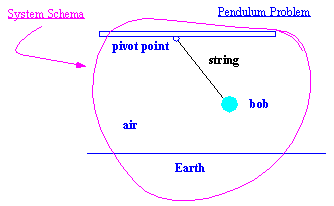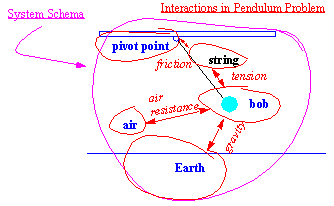
A System Schema is a useful tool for modeling scientific problems. It is
basically a sketch in which you identify all factors relevant to the scientific
phenomenon being studied. A System Schema is a way to inventory the relevant
elements in a problem.

In the case of a swinging pendulum a System Schema is shown in the diagram, where all possible objects within the circle have been identified as part of the System defined by the scientific question posed in the experiment. In this case the scientific question is: What Factors Determine the Swing Cycle of a Pendulum?
A System Schema is basically a diagram that summarizes the relevant elements in a system, and should help you identify the important variables in any experiment or problem. In the case of the swinging pendulum, the System Schema includes the pendulum bob, the string, the pendulum suspension point in the ceiling, the Earth, and perhaps the air (which causes a minute amount of air resistance). Note that some of these variables are much more important than others in determining the swing cycle of a pendulum. Frequently in science, we examine the variables, and ignore those that have a negligible effect on the question raised. Can any of the variables identified in the System Schema above be ignored in addressing the question: What Factors Determine the Swing Cycle of a Pendulum? Once the relevant elements of a System have been identified with the help of a System Schema, we next consider the interactions that are relevant to the problem or scientific question posed. If the question posed is: What Factors Determine the Swing Cycle of a Pendulum?, we are basically asking what variables are significant in affecting the period of a pendulum?s back-and-forth motion. So it is helpful to indicate on the System Schema diagram the interactions relevant to the problem.
In the case of the swinging pendulum, the gravitational interaction between the Earth and the pendulum bob can be identified as the primary interaction. Note that we assume here that the problem begins with the total energy of the system determined before hand. Initially the total energy of the system was set by the "pull-back distance"or height the pendulum bob was raised from its rest position. What was the source of that energy? What kind of energy is it? Examining the System Schema makes it easy to identify all possible interactions that affect the swing cycle of the pendulum. The frictional interaction between the pivot point in the ceiling and the string tends to slow the pendulum motion. The interaction of the string tied to the pendulum bob creates a varying upward tension on the bob. The interaction between the swinging bob and the surrounding air creates a drag effect on the bob (air resistance) that, although very small, tends to slow the motion of the bob. Which of these interactions can be ignored and which are significant?
